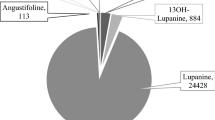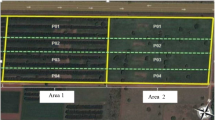Abstract
Carex brevicollis (Cyperaceae) is a plant of mesic grasslands in calcareous mountains of southern Europe. It contains two different β-carboline alkaloids, brevicolline and brevicarine, the first of which is thought to produce abortions in mammals. In the rangeland of Aliva, within the Picos de Europa massif in northern Spain, the abundance of Carex brevicollis has been linked with the occurrence of teratogenesis in early gestating cows grazing in early summer. The concentration of alkaloids was measured in the summers of 2007 and 2008, at intervals of 2 weeks, at different altitudes within the rangeland (1,350, 1,600, and 1,850 m) and from different parts of the sedge (leaves, reproductive stems, and inflorescences). Estimated growing degree days were related to the flowering phenology of Carex brevicollis and were used to analyse its relation with the concentration of alkaloids. Brevicarine concentration was higher in inflorescences and brevicolline in leaves. Although it also depended on the zone and year, the concentrations of both alkaloids were related one to another in leaves and inflorescences but not in stems. Both alkaloids decreased with growing degree days in the inflorescences and showed no response in leaves. Our findings suggest that brevicarine, not brevicolline, could be the teratogen in pregnant cattle in this region. This hypothesis is supported by the observed frequent consumption of inflorescences and scarce consumption of leaves of Carex brevicollis by grazing livestock, and also by the coincidence of the toxicity in early pregnant cows with the flowering time of the sedge.







Similar content being viewed by others
References
Adler, L.S., Karban, R., and Strauss, S.Y. 2001. Direct and indirect effects of alkaloids on plant fitness via herbivory and pollination. Ecology 82:2032–2044.
Adler, L.S., and Irwin, R.E. 2005. Ecological costs and benefits of defenses in nectar. Ecology 86:2968–2978.
Bedia, J., Cabañas, S., and Busqué, J. 2009. Productivity and plant diversity are related to a community functional signature in mountain grasslands, pp. 79–82, in Proceeding of the 15th Meeting of the FAO CIHEAM Mountain Pastures Network. Switzerland. http://fao09.adcf.ch/proceeding.php
Busqué, J., González, G., Agote, L., Benoit, S., Gutiérrez, J.M., Mora, M.J., and Bedia, J. 2008. Teratogénesis en vacuno en los pastos de puerto de Áliva (Picos de Europa). Análisis de encuestas a los ganaderos, pp. 589–595, in Pastos, Clave en la Gestión de los Territorios: Integrando Disciplinas. Proceedings of the Annual Meeting of the Sociedad Española para el Estudio de los Pastos.
De Bello, F., Leps, J., and Sebastiá, M.T. 2005. Predictive value of plant traits to grazing along a climatic gradient in the Mediterranean. J. Appl. Ecol. 42:824–833.
Cao, R.H., Peng, W.L., Wang, Z.H., and Xu, A.L. 2007. Beta-carboline alkaloids: biochemical and pharmacological functions. Curr. Med. Chem. 14:479–500.
Carey, D.B. and Wink, M. 1994. Elevational variation of quinolizidine alkaloid contents in a lupine (Lupinus argenteus) of the Rocky Mountains. J. Chem. Ecol. 20:849–857.
Curran, S., Pierson, R.A., and Ginther, O.J. 1986. Ultrasonographic appearance of the bovine conceptus from days 20 through 60. J. Am. Vet. Med. Assoc. 189:1295–1302.
Dunne, J.A., Harte, J., and Taylor, K.J. 2003. Subalpine meadow flowering phenology responses to climate change: integrating experimental and gradient methods. Ecol. Monogr. 73:69–86.
EUROPEAN COMMISION. DG ENVIRONMENT. 2007. Interpretation Manual of European Union Habitats. 142p.
Gay, C.C, Motteram, E.S., Panter, K.E., and Wierenga, T. 2007. Year-to-year variation in alkaloid concentration in Lupinus leucophyllus growing on the Scablands of central Washington, pp. 414–419, in K.E. Panter, T. Wierenga, and J.A. Pfister (eds.). Poisonous Plants: Global Research and Solutions. CABI International, Wallingford.
Gómez, D., Azorín, J., Bastida, J., Viladornat, F., and Codina, C. 2003. Seasonal and spatial variations of alkaloids in Merendera montana in relation to chemical defense and phenology. J. Chem. Ecol. 29:1117–1126.
Grime, J.P., Hodgson, J.G., and Hunt, R. 2007. Comparative Plant Ecology. A Functional Approach to Common British Species. 2nd edn, p. 748. Castle Point Press.
Harborne, J.B. 1991. The chemical basis of plant defenses, pp. 45–59, in R.T. Palo, C.T. Robins (eds.). Plant Defenses Against Mammalian Herbivory. CRC, Boca Raton.
Inouye, D.W., Saavedra, F., and Lee-Yang, W. 2003. Environmental influences on the phenology and abundance of flowering by Androsace septentrionalis (Primulaceae). Am. J. Bot. 90:905–910.
Lee, S.T., Ralphs, M.H., Panter, K.E., Cook, D., and Gardner, D.L. 2007. Alkaloid profiles, concentration and pools in Velvet Lupine (Lupinus leucophyllus) over the growing season. J. Chem. Ecol. 33:75–84.
Mahboobi, S., Wiegrebe, W., and Popp, A. 1999. Synthesis of enantiomerically pure (-)-(S)—Brevicolline. J. Nat. Prod. 62:577–579.
Marcu, G.A. 1965. Tr. Tret´ei Nauchn. Konf. Molodykh Uch. Mold. Boil. S kh Nauki, 243. Chemical Abstracts 63:2297.
Muzquiz, M., Burbano, C., Cuadrado, C., and De La Cuadra, C. 1993. Determinación de factores antinutritivos termorresistentes en leguminosas. I. Alcaloides. Revista Investigación Agraria. Producción y Protección Vegetales, 8:351–361.
Muzquiz, M., Cuadrado, C., Ayet, G., De La Cuadra, C., Burbano, C., and Osagie, A. 1994. Variation of alkaloid components of lupin seeds in 49 genotypes of Lupinus albus L. from different countries and locations. J. Agric. Food Chem. 42:1447–1450.
Pakeman, R.J. 2004. Consistency of plant species and trait responses to grazing along a productivity gradient: a multi-site analysis. J. Ecol. 92:893–905.
Panter, K.E., Motteram, E., Cook, C., Lee, S.T., Ralphs, M.H., Platt, T.E., and Gay, C.C. 2009. Crooked calf syndrome: managing lupines on rangelands of the Channel Scablands of east-central Washington State. Rangelands 31:10–15.
R DEVELOPMENT CORE TEAM. 2009. R: A language and environment for statistical computing. R Foundation for Statistical Computing. Vienna, Austria. ISBN 3-900051-07-0, URL http://www.R-project.org.
Ralphs, M.H., Manners, G.D., Pfister, J.A., Gardner, D.R., and James, L.F. 1997. Toxic alkaloid concentration in tall larkspur species in the western U.S. J. Range Manag. 50:497–502.
Rivas Martínez, S., Díaz, T.E., Prieto, J.A.F., Loidi, J., and Penas, A. 1984. La Vegetación de la Alta Montaña Cantábrica. Los Picos de Europa. p. 295. Ediciones Leonesas.
Ruiz De Los Mozos, I., Oreja A., San Emeterio, L., Zabalgogeazcoa I., and Canals, R.M. 2008. Troublesome plants in species-rich grasslands: can we maintain the toxic plant Carex brevicollis and alleviate its risk to livestock? pp. 66–68, in Grassland Science in Europe 13.
San Emeterio, L., Ruiz De Los Mozos, I., Oreja, A., Zabalgogeazcoa, I., and Canals, R.M. 2008. Origen de la toxicidad en Carex brevicollis: una especie frecuente en pastos montanos templados, pp. 255–260, in Pastos, clave en la Gestión de los Territorios: Integrando Disciplinas. Proceedings of the Annual Meeting of the Sociedad Española para el Estudio de los Pastos.
Sandwith, N.Y., and Montserrat, P. 1968. Aportación a la flora pirenáica. Pirineos 79–80:21–74.
Sharipov, I.N., Cheban, N.N., Kondratenko, B.S., Terenteva, I.V., and Lazurevskii, G.V. 1975. Alkaloid accumulation in cultivated and naturally growing Carex brevicollis. Izvestiya AN Mold SSR, Ser. Bio. I Khim. N 6:63–67.
Terenteva, I.V., Lazurevskii, G.V., and Shirshova, T.I. 1969. The structure of brevicarine. Chem. Nat. Compounds. 5:330–404.
Vember, P.A., Terenteva, I.V., and Lazurevskii, G.V. 1967. Structure of brevicolline. Chem. Nat. Compounds 3:249–253.
Wagner, F.F., and Comins, D.L. 2006. Six-step synthesis of (S)-Brevicolline from (S)-Nicotine. Organic Lett. 8:3549–3552.
Yasnetso, V.S., and Sizov, P.I. 1972. Mechanism of brevicolline, thalictrimine and pachycarpine action on uterus. Farmakologiya I Toksikologiya 35:201.
Wink, M. 1993. Quinolizidine alkaloids, pp. 197–239, in P. Waterman (ed.). Methods in Plant Biochemistry. V.8. Academic, San Diego.
Acknowledgments
This work was financially supported by the Spanish Research Institute for Food and Agriculture Technology (INIA RTA2009-00129) and by the Government of Cantabria (CIFA-INIA agreement CON08-043). The authorities and personnel of the Picos de Europa National Park offered invaluable support during field work. Finally, we wish to thank Guy Beaufoy, Matt Doughty, and two anonymous reviewers for help in improving this manuscript.
Author information
Authors and Affiliations
Corresponding author
Rights and permissions
About this article
Cite this article
Busqué, J., Pedrosa, M.M., Cabellos, B. et al. Phenological Changes in the Concentration of Alkaloids of Carex brevicollis in an Alpine Rangeland. J Chem Ecol 36, 1244–1254 (2010). https://doi.org/10.1007/s10886-010-9865-4
Received:
Revised:
Accepted:
Published:
Issue Date:
DOI: https://doi.org/10.1007/s10886-010-9865-4




